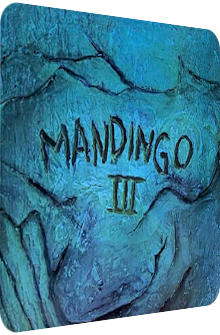
Mandingo
Mandingo III
1974
50% Funk, 50% Exotica? There's only one project where these genres mesh harmoniously, called Mandingo, of course, and this time, they even add a third genre called Reggae to their style, but more about this later. British band leader and visionary Funk maestro Geoff Love (1917–1991), flacked by producer Norman Newell (1919–2004), is gathering lots of unnamed and unmentioned session musicians around him once again in order to deliver his third Jungle Funk piece, called Mandingo III, that for the first time comes with an intriguing subtitle attached to it: A Story Of Survival. Wow, doesn't this sound intensely exciting?
A Mandingo album telling a story with the help of electric guitars, brass bursts, tribal flutes, vivid bongos and a concoction of state-of-the-art electronic sound effects… now that's exactly what the doctor prescribed. Aural cinematography has always played as big a part in Mandingo's music, as loads of smashing cymbals, both eclectic and downbeat drum patterns and gleaming trumpets encounter each other, and Mandingo III drives this concept further, not only due to its promised overarching theme, but thanks to its concept song. Yes, there's one track on side A that encompasses two compositions at the same time. Speaking of compositions: four prolific writers of different genres present 12 (technically 11) unique songs that come to fruition under the watchful eyes of Geoff Love.
Since the inclusion of the album's alternative title is prominently featured, I am more critical in this review than usual in regard to Mandingo's Funk Exotica, for this album promises a story arc, whereas all of their other albums – Sacrifice (1973) and Savage Rite (1975), for instance – can be rightfully perceived as a collection of songs. So let's see whether this album lives up to its own hype, and whether there are things that didn't work out so well in the end.
Mandingo III opens in a mystical fashion with a song by Mike Vickers. In fact, each and every song off side A has been written by him. Invocation To The Gods launches with a rising three-note flute-evoking synthesizer motif, followed by a temple gong and a splendid bongo groove. The electric guitar twangs that are introduced are both warm and acidic, containing the oxymoronic carefree in-your-face attitude that's scattered throughout the whole Funk genre. A spiraling bass flute melody plays along with the synthesizer, and once a few trumpet accentuations occur – rather weak and reduced for a Mandingo song –, the arrangement just receives another layer of Funk in its exotic setting. Invocation To The Gods disappoints as an opener, the melodies are rudimentary, the beats schlep themselves forward, only the bongo thicket can impress. Everything else purposefully underwhelms, as the band doesn't start things with a bang, presumably to let the tension rise further.
The following big band-heavy War Dance already heats things up with four-note horn stabs, a warbled space pad, threatening timpani and rattling shakers. The drums are the selling point of this piece, and this time, less is more. They are revved up and accompanied by electric guitars and sunset-trombones in the second phase of the song, but the rustic start boosts the intimidating atmosphere. On the right volume levels, the drums are earth-shattering. All in all, War Dance disappoints as well, I'm afraid. The interplay between the melodies and percussion instruments is yet again surprisingly reduced, with no clever intersections or eclectic drum patterns in sight. Sure, the song is a showstopper thanks to its punchy drums, but it doesn't feature much else beyond the dusky aura.
The next composition is different, though. Comprising of two parts, A) Watching And Waiting and B) Battle, it is a proper concept song, totally out of this world and catchy it is, too. The first part is notable for its inclusion of Reggae- or Dub-inspired sound patterns: a laid-back wah-wah bass guitar groove and gorgeously galactic, if slightly clichéd organ riffs mesh with clicking rainsticks, dizzy triangles and delicate marimba droplets. After more than 90 seconds, a pause marks the beginning of B) Battle that lifts off with spacey zipper-like oscillating laser sounds and an increasing tempo. The accompanying organ floats in the background, while glitzy Funk guitars accentuate an eleven-note staccato brass scheme that is – finally – of typical Mandingo quality, despite the ever-changing roster of session musicians. The zipper-like synth is stereo-panned to the max, screeching and whirling quickly in juxtaposition to the hectic cowbells and bongos. An absolutely stunning pre-Star Wars piece that merges Funk, Reggae, Space-Age and Exotica with ease. A tense ride that is the cream of the crop of Mandingo III. Writer Mike Vickers comes up with his most imaginative piece ever.
Forwards ever, backwards never, that's also the case with Celebration and its point of departure, a marimba-accentuated synth-and-trumpet siren that leads to one of those typical Boogie Woogie grooves that has the 70's written all over it. It's a Pop song even by Mandingo's standards, with harpsichord backings, bass guitars riffs, golden gleaming trumpets and the occasional acoustic guitar involvement. The melody is saccharine and jolly, but somehow manages to stay close to the Funk business. Another huge composition, not exotic at all, but oh so catchy. It's also fully compatible with workout playlists and makes me smile all the time.
Triumphant March finishes side A and is, I have to say it clearly, so distasteful that it is actually a stellar tune! Technicolored brass fanfares are set against the typical military march drums and cymbals. So far, so stupid. What makes this song work nevertheless is the percussion, the warm dubby bassline and the flangered electric guitar that roars like a leopard, as well as the tweaked trumpets that sound like spectral, time-traveling beings. A short female chanter rounds this overproduced song off. I'm still not sure what to think of it. Its mood is truly jocular and blithesome, and yes, it is also catchy, but it's too syrupy and completely detached from the jungle craze which has always been the overarching theme of every Mandingo album. If you want that certain stand-outsong by the project, it's definitely this one. It stands out for the worse, I believe, but it shows the wide variety of styles the arrangers and writers interweave.
Side B launches as if the preceding side never existed, presumably because of the omission of any Mike Vickers piece. Now it's time for the other writers to showcase their talent. Drums In The Night, the only song written by Roger Webb, paints an enigmatic moon-lit scenery with the help of cymbals, slightly Middle Eastern-flavored alto flutes and careful woodstick percussion. Shortly before the one-minute mark, a piano-electric guitar couple is set against a bongo beat that's further fueled by a droning bass guitar. Meandering trumpets increase the tension, but it is not until they become polyphonous and eruptive that the glistening pastel dusk changes into colorful cascades of Steppe-loaded visions. A great track whose ambience I admire as much as the ensuing crescendo.
Madame Alyn Ainsworth provides the next two pieces: while the perniciously titled Bodysnatcher encapsulates shedloads of sneaky, a tad eerie and definitely more serious flute and brass sections in a splendidly tribal 6/8 skeleton and rounds the song off with the most frantic, hyper-pumping bongo force on the whole album, the city strolling take The Headhunter exchanges sneakiness with sleaziness, Exotica with Funk, relies on crunchy, well, Funk guitars instead of their bass brethren and intertwines sizzling-hot organ streams with dark brass bits and oscillating wah-wah synth effects. Instead of lush jungles, this song is all about a sun-perturbed concrete jungle and a cosmopolitan Funk downbeat that perfectly meshes with the expected Mandingo style.
Nick Ingman presents the next two compositions, one of them focusing on the timpani tribalism in Witch Doctor with its paradisiac flutes, crunchy fret guitars, dangerously glowing Reggae organ pulses, trumpet-related war fanfares and threatening bass accentuations, while the other one called Maneater is a sun-soaked piece of laissez-faire and happiness with an utterly catchy and well-texturized Funk guitar accompaniment, warbled wind chimes, whirring organs in the background, catchy flutes and an overall great entanglement of the instruments. The few marimba sprinkles augment the iridescence of the presentation. You've nothing to fear, nothing to lose. The final piece is called Mumbo-Jumbo and is the third song by Alyn Ainsworth, delivering one last panorama full of bongos, smooth alto flutes that play in deeper regions as well as pitch-black bass guitars. The plasticity of the percussion is great and the vestigial melodies help the implied tribalism and faux-savageness. Mandingo III closes with great style as the song fades out for good.
And thus ends an album that's curiously indecisive about its course. Mandingo III disappoints as an album, even more so since the auspicious subtitle A Story Of Survival promises some kind of a concept album. But this is not the case at all. It's merely a collection of – thankfully original – tunes that merge Funk, Exotica and even Reggae with great success and always flawlessly. The greatest stylistic variety of any Mandingo album comes with a price, and you can probably sense where my sentence is going: a great album mediates between variety and coherence. Mandingo III fails in this regard, though the failure isn't devastating in the slightest, as two absolute stompers, both by Mike Vickers, are included on this LP which outshine almost everything else: A) Watching And Waiting and B) Battle is a hugely intriguing concept song that is as funky as it is exotic, whereas the Boogie Woogie infusion of Celebration is far away drum Exotica realms, but tries to camouflage this fact with catchy brass melodies and a positively wacky rhythm.
And then we have the audacious Triumphant March that feels so wrong, is so out of place, but tries to enchant the listener with its saccharine fanfare structure and brass stabs – and it works way better than the military marches Arthur Lyman was occasionally placing on his 50's Exotica albums. Mandingo III is, all in all, an album I can recommend, for it caters to the needs of both the Funk and Exotica crowd after a lackluster start. Since all compositions are unique, I don't have any real complaints, but want to stress the fact that of all Mandingo albums, this one is the jumpiest, trying to bring together the many styles of its different writers. It's a song-driven LP, not a topic-driven one, despite its promising title. If you don't mind this nit-picking observation, fall prey to Mandingo, I dare you!
Exotica Review 119: Mandingo – Mandingo III (1974). Originally published on Sep. 8, 2012 at AmbientExotica.com.
